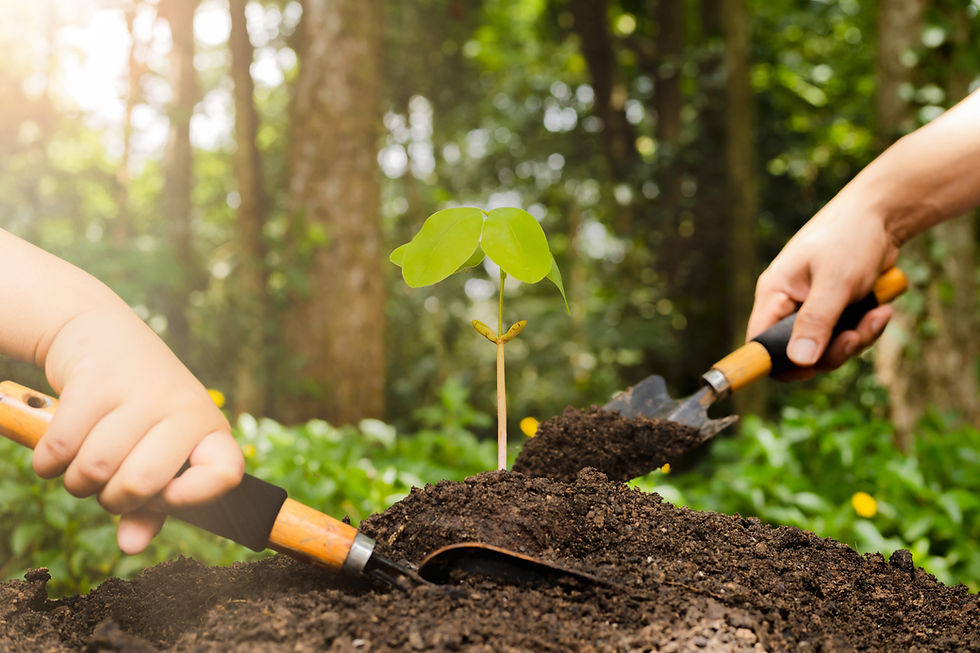How to Properly Plant a Tree?
- Treeline Management
- Oct 31, 2024
- 4 min read
Updated: Feb 10
Planting a tree is one of the most rewarding things you can do for the environment and your community. Trees not only improve air quality and provide shelter for wildlife but also bring beauty and shade to your yard. However, to ensure your tree thrives, it's crucial to plant it the right way. Let us help you plant a tree properly.💚
Best Time to Plant
The best time to plant a tree can depend on where you live and what type of tree you’re planting. In the Northeastern U.S., for instance, early spring or late fall are ideal because these times give trees a chance to grow roots before the harsh weather kicks in. It’s important to understand your local climate to make sure your tree has the best chance of growing strong and healthy.

Choosing the Right Tree Species
Selecting the right tree species is essential. Look for trees that will thrive in your area and fit well with your planting conditions. Consider how large the tree will grow and ensure there’s enough space for it away from buildings and other trees. If you’re unsure, consult with local arborists or gardening experts—they can provide valuable advice on the best species for your location.
By the way, click here and decide which plant you would like to grow 🌲

Site Preparation
Digging the Hole
When it comes to digging the hole for your tree, it’s important to do it right. The hole should be 2 to 3 times wider than the root ball but no deeper than the root ball itself. A good rule of thumb is to make the hole about 3 inches deeper to give the roots some room to grow.
Wind Protection
If your planting spot is windy, think about creating a natural windbreak. This could be as simple as using nearby plants or structures to help shield your young tree from strong gusts.
Removing the Seedling
When you're ready to take the tree out of its container, do it carefully. Loosen any roots that are tightly bound but be gentle—don't pull on the trunk, as that can cause damage.
Positioning the Tree
Place the tree in the hole with the root flare (the part where the trunk meets the roots) above ground by about 2 inches. This positioning is crucial for the tree’s health.
Adjusting the Depth
Before you start backfilling, double-check that the depth is correct. The root flare should remain visible to help the tree establish itself better.

Backfilling and Watering
Backfill with Native Soil
Once your tree is in place, backfill the hole with the native soil. Be sure to pack it gently around the root ball to eliminate any air pockets.
Create a Berm
Make a small raised ring of soil around the tree. This will help direct water toward the base of the tree when you water it.
Mulching
Add a layer of mulch, about 2 to 3 inches thick, in a donut shape around the tree, keeping it away from the trunk. This helps retain moisture and prevents weeds.
Watering
Water the tree regularly, aiming for about 1 gallon of water each week. It’s essential to keep the soil moist but not soggy, especially during the first few weeks after planting.

Follow-Up Care
Avoid Fertilizing Immediately
It’s tempting to fertilize right after planting, but it’s best to wait until the tree is established. Focus on helping the roots develop first.
Monitor Watering
Pay attention to the weather. Adjust your watering schedule based on rainfall and temperature, gradually tapering off in cooler months.
Look for Signs of Distress
Keep an eye on your tree for any signs of stress, like wilting or discolored leaves. If you notice problems, adjust your care accordingly.

How to Avoid Utility Conflicts?
Before you start digging, check for overhead and underground utility lines. Make sure your tree is planted a safe distance away from these lines to prevent any future issues. Always call your utility company to locate underground lines before digging.

Seek Expert Help for Thriving Trees
If you ever feel uncertain about any step in the tree-planting process, don't hesitate to reach out for professional help. Experts can provide personalized guidance based on your specific conditions and the type of tree you want to plant. They can help ensure you're choosing the right species, planting at the optimal time, and caring for your tree as it grows. Whether it's advice on site preparation or ongoing maintenance, getting professional support can make your planting experience even more successful and enjoyable. Remember, a healthy tree today can become a beautiful part of your landscape for years to come!

Conclusion
Properly planting a tree or shrub is essential for its survival and growth. By following these steps, you can contribute to a greener planet while also enhancing your personal space. Whether you’re planting one tree or participating in a larger project, taking the time to do it right will ensure your efforts are worthwhile. Happy planting!
At Treeline Hedge Landscaping, we’re all about bringing your outdoor spaces to life with professional landscaping, tree care, and more! If we’ve had the pleasure of working with you, we’d love for you to share your experience in a review. Let’s keep your landscape thriving together!
.jpg)



Comments